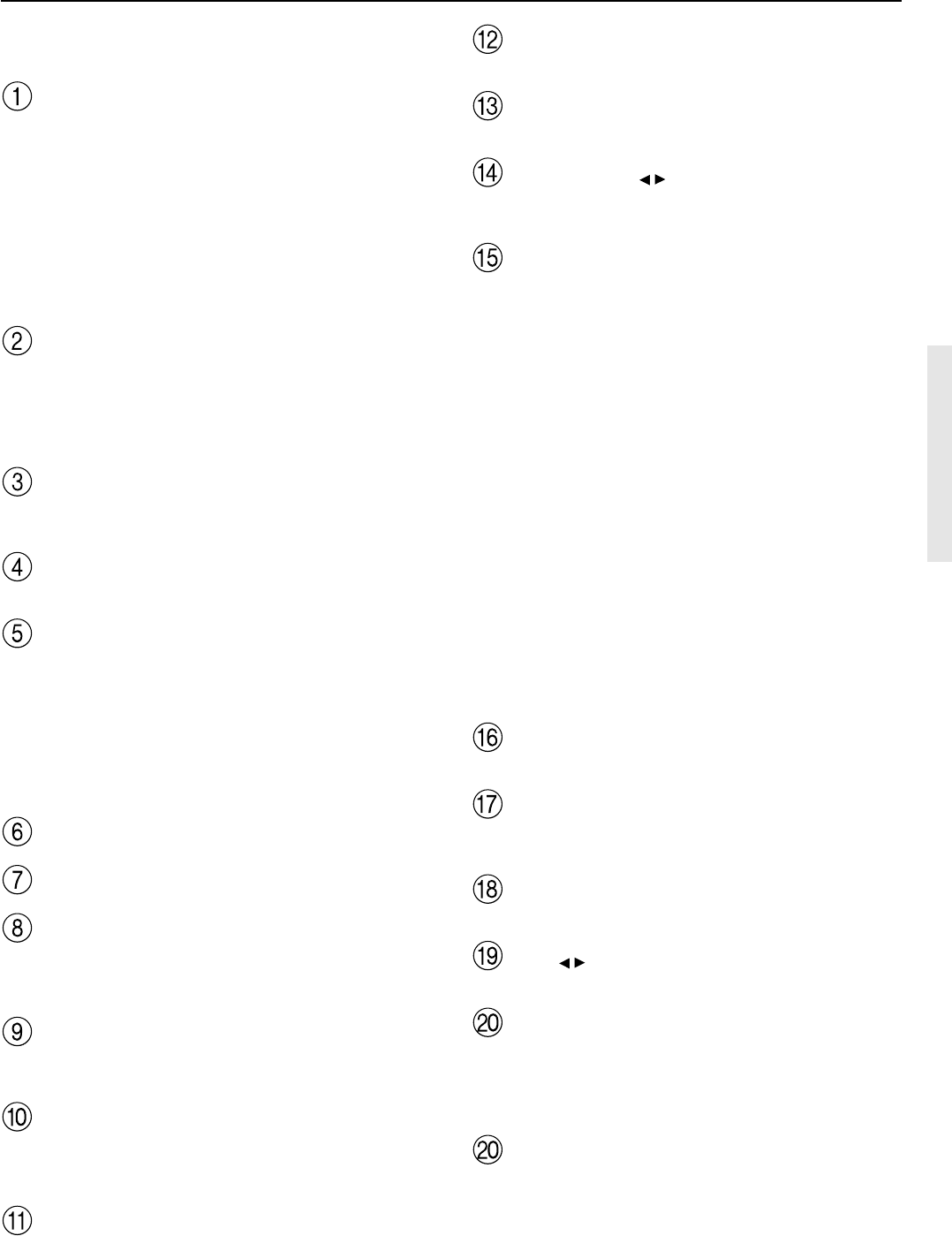
9
Index parts and facilities
For further operational instructions, see the pages indicated in
brackets [ ].
POWER switch (for all models other than USA and
Canadian models) [30]
Press to turn on and off the main power supply for the TX-NR900/
900E. When the TX-NR900/900E is turned on with the POWER
switch, the STANDBY indicator lights.
• Before turning on the power, check to make sure that all cords
are properly connected.
• When the power is turned on, a sudden surge of current will
occur that may adversely affect the operation of other devices.
To prevent this, do not plug the TX-NR900/900E into the same
circuit used by sensitive equipment, e.g., computers.
STANDBY/ON button [30]
If pressed with the POWER switch turned on (with the receiver
plugged in for US models), the TX-NR900/900E turns on and the
display lights up. If pressed again, the TX-NR900/900E returns to
the standby state. In the standby state, the display is turned off and
the TX-NR900/900E cannot be operated.
STANDBY indicator [7, 30]
Lights when the TX-NR900/900E is in the standby state and when a
signal is received from the remote controller.
AUDIO SELECTOR button [35]
Press to select the type of audio input signal.
Input source buttons and indicators (DVD, VIDEO
1–5, TAPE, TUNER, PHONO, CD, and NET AUDIO)
[31, 36, 40, 42]
Press these buttons to select the input source for the main zone.
To select the input source for the remote zone (Zone 2) or recording
out (Rec Out), first press the ZONE 2 or REC OUT button, and then
press the desired input source button. The input channel with its
indicator lit red is output to REC OUT and the one with its indicator
lit green is output to ZONE 2.
Front display
Remote control sensor [7]
DISPLAY button [34]
Press to display information about the current input source signal.
Each time you press the DISPLAY button, the screen changes to
show you different information concerning the input signal.
MASTER VOLUME dial [35]
Use to control the volume in the main zone. The volume for the
remote zone (Zone 2) is independent.
UPSAMPLING indicator [59]
Lights during upsampling. This function is available when the input
source is Analog/PCM and the listening mode is set to the stereo or
surround mode.
PURE AUDIO indicator [33]
Lights during pure audio playback.
DIRECT/PURE AUDIO button [33, 35]
Press to switch between the direct and pure audio listening modes.
PHONES jack [32]
This is a standard stereo jack for connecting stereo headphones.
ZONE 2 LEVEL / buttons [43]
Press to enter the mode for adjusting the volume in the remote zone
(Zone 2).
REC OUT/ZONE 2/OFF buttons [40-43]
These buttons allow you to use the TX-NR900/900E to output to a
remote zone (Zone 2) or to another component for recording (Rec
Out). Press the REC OUT button to output the audio and video
signals to a recording component for recording. Press the ZONE 2
button to enjoy the output from the TX-NR900/900E in a different
room, which is referred to as the remote zone (Zone 2).
When either button is pressed, the currently selected input source for
recording or outputting to the remote zone is displayed in the front
panel display. If “SOURCE” is displayed, then the same input
source as that selected for the main zone will be output.
To select an input source, press the desired button (REC OUT or
ZONE 2) and then press one of the input source button within 8
seconds. That source will be output for recording or viewing in the
remote zone.
To set the output to the source channel, press the desired button
(REC OUT or ZONE 2) twice in succession. To turn off the output,
press the desired button (REC OUT or ZONE 2) and then press the
OFF button within 8 seconds.
Note:
The Rec Out and Zone 2 buttons use the same circuit and therefore
cannot be used at the same time. When REC OUT is selected,
nothing is output to Zone 2. When ZONE 2 is selected, REC OUT is
automatically fixed to SOURCE.
STEREO button [33]
Selects for the stereo listening mode.
SURROUND button [33]
Selects for the Dolby Pro Logic II, DTS Neo:6, Dolby Digital, or
DTS listening modes.
THX button [33]
Selects for the THX listening mode.
DSP / buttons [33]
Switches to the DSP (Digital Signal Processing) modes.
DIMMER button (Other than European models) [34]
Press to set the brightness of the front display. There are three
settings available: normal, dark, and very dark.
• The brightness of the front display can also be performed using
the remote controller.
RT/PTY/TP button (European models only) [39]
This button is only available on European models. Press this button
to tune into the Radio Data System (RDS) for FM broadcasting. RDS
was developed within the European Broadcasting Union (EBU) and
is available in most European countries. Each time the button is
pressed, the display changes from RT (radio text) to PTY (program
type) to TP (traffic program) and then back to RT again.


















